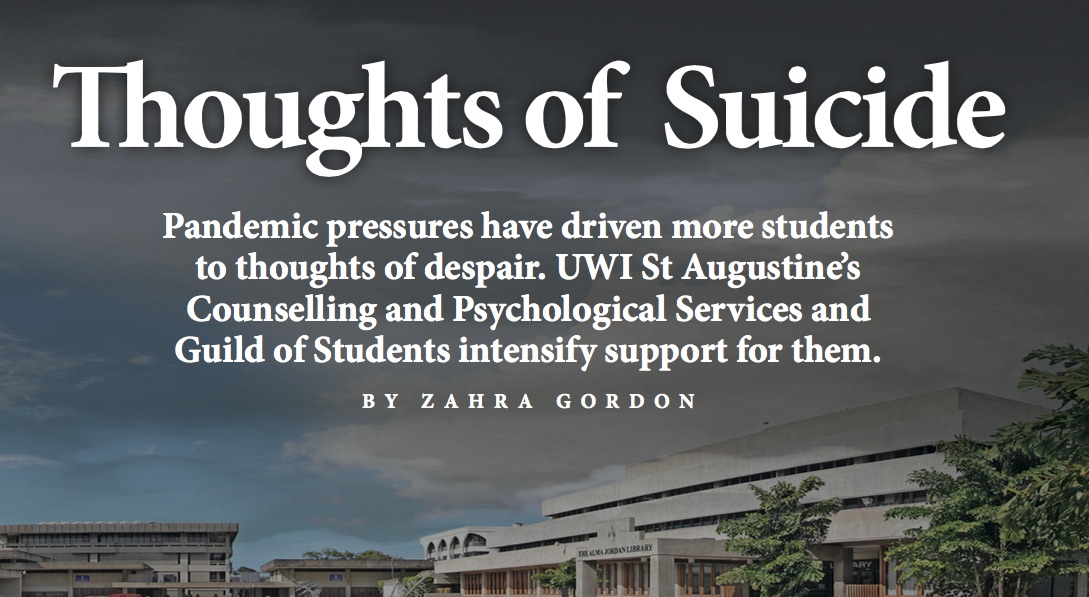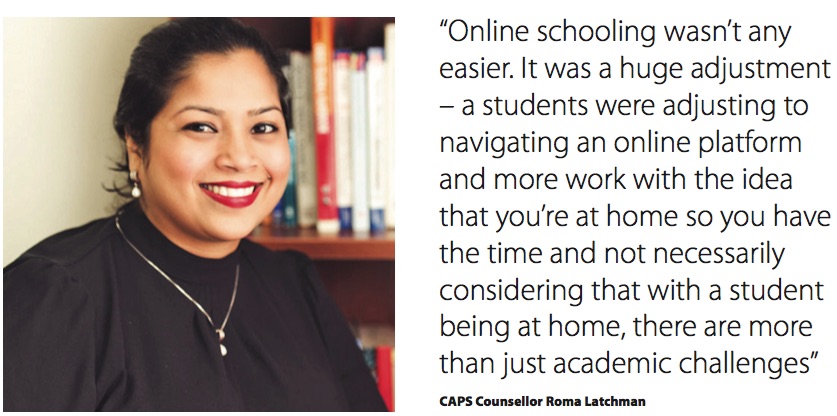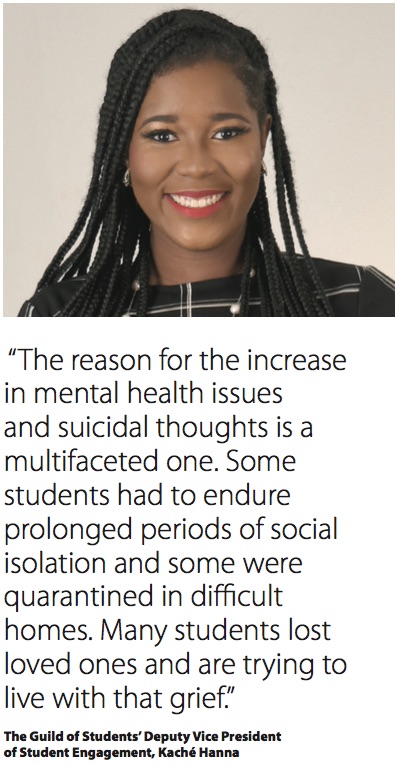
At the onset of the pandemic, there was global uncertainty and despair. The sudden plunge into lockdown left many unemployed and more without a strong social network. Safe spaces such as schools were suddenly closed and the negative impacts on youth mental health would soon emerge as a grave concern. The UWI St Augustine campus was no different and as the pandemic continues, there appears to exist a rise in suicidal ideation.
However, The UWI may simply present a microcosm of a national dilemma. Over the past three years, there has been an increase in deaths by suicide nationally. In 2019, there were 92 completed suicides, according to Ministry of Health data. In 2020 and 2021, there were 104 and 128 completed suicides respectively. When these numbers are further broken down by gender, men account for 79.8 percent of the completed suicides and the increase in 2021 was four times the 2020 number for men specifically.
On a regional scale, Trinidad and Tobago has the third highest suicide rate in the Caribbean according to the World Health Organisation (WHO). The Counselling and Psychological Services (CAPS) Department coordinator Dr Sarah Chin Yuen Kee said that, since the pandemic, more than half of the students who access CAPS services experience suicidal ideation and The UWI unfortunately lost a member of the student body to suicide in early 2022. Moreover, the volume of students accessing CAPS counselling services not only for suicidal ideations, but a myriad of emotional and psychological concerns, has also increased.
Dr Chin Yuen Kee explained that there are numerous factors relating to these increases.
“Since the pandemic, all services have moved online and I think that has made counselling a lot more accessible. More students are using the service throughout the year. Also, because of COVID-related reasons, we’re observing an increase in severity of mental health issues,” said Chin Yuen Kee during an interview with UWI TODAY. “Normally, there may be a percentage of students who come for developmental reasons, but now the majority are presenting with depression, anxiety and deterioration in pre-existing conditions so when they are presenting, it tends to be more critical than it used to be.”
She further explained that while many news reports focus on COVID-related mental health issues among school-aged children, young adults are equally at-risk.
“Pre-COVID, the two most common presenting concerns were: mood disorders or depression-related symptoms and inter-personal issues. Since COVID, the clinicians have picked up on a pattern of difficulty at home for many students. At best it might be unsupportive, at worst it might be hostile or abusive. A lot of students would express that coming to campus was a rare break for them, an opportunity to get away from an abusive environment. So not being able to access campus caused many of our students to have new issues because they were in difficult living arrangements.”
A particular concern to students was the loss of socialisation. “Many students might have deteriorated during that time firstly because they were living in difficult circumstance and secondly because they had lost access to their social support. Peer support has been a vital resource for a lot of our students who would otherwise be struggling and so when COVID social distancing came into play, a lot of our students were feeling very isolated and lonely,” added Chin Yuen Kee.
The Guild of Students Deputy Vice-President of Student Engagement Kaché Hanna said that in her conversations with students over the past two years, she’s heard many express feelings of immense pressure mixed with fear and sadness.

Hanna shared her own reasons for the rise in ideation among students: “The reason for the increase in mental health issues and suicidal thoughts is a multifaceted one. Some students had to endure prolonged periods of social isolation and some were quarantined in difficult homes. Many students lost loved ones and are trying to live with that grief. During the onset of the pandemic, many parents lost their jobs and some families are still going through financial hardships. The pandemic has also caused a spike in gender-based violence and some students were isolated in environments that resulted in them being victims of sexual assault. There are myriad reasons why suicidal thoughts have increased in students.”
An additional stressor was the extra academic workload and the faulty idea that online education was somehow easier to manage.
“Online schooling wasn’t any easier. It was a huge adjustment – a students were adjusting to navigating an online platform and more work with the idea that you’re at home so you have the time and not necessarily considering that with a student being at home, there are more than just academic challenges,” noted CAPS Counsellor Roma Latchman. “Students had more household responsibilities, more inter-personal conflict or they just had to adjust to a shared space with family members. Studying from home doesn’t mean you have the world of time to complete studying and that unexpected adjustment stressed students out mentally. For those who already suffered from some type of mental health disorder, it was exacerbated under duress and could’ve brought about poor coping skills,” said Latchman.
The CAPS offers many services to students including one-on-one counselling, peer counselling training, psycho-educational workshops, support groups and risk-assessments for students in crisis. The department has also hosted virtual walk-ins and meditation sessions since the beginning of the pandemic. However, the increased demand for one-on-one counselling meant that some outreach programmes suffered in recent times. “The deluge of demand for individual counselling meant that some outreach needed to be temporarily suspended or scaled back. We would usually have a series of psycho-educational workshops, but didn’t have the resources to put those on while still managing the counselling requests,” shared Chin Yuen Kee.
Due to confidentiality, it can’t be said if the student who completed suicide had reached out for services, but the counsellors are nonetheless devastated by the loss. “For a small team of hardworking therapists, it is devastating when a student commits suicide because we’re very aware of what someone who battles with suicidal thoughts would’ve gone through. And it’s always sad to know that somebody has been battling with that kind of pain that would’ve led to a suicide. At this point, most of our students present with some type of suicidal ideation. This has become the work for all of the counsellors, so we are well aware of the agony that someone goes through. You wonder what we can do to get more people to access services,” noted Chin Yuen Kee.
Latchman expressed similar sentiments. “It’s quite difficult to find a silver lining when you lose someone. Part of us would know that an inevitable part of life is death, but death is such a complex and complicated element when a person has to navigate it that it’s difficult.

Hanna believes that more needs to be done to destigmatise mental illness, not only on campus, but nationwide. “A person can be suicidal for various reasons such as experiencing feelings of hopelessness or undergoing traumatic stress. Thus, it is crucial to identify all of the various factors. We as a society, have a responsibility to change the narrative about suicide so that individuals don’t feel ashamed to say they are experiencing suicidal thoughts. We must all aim to create a safe environment, so that our friends and family members know they can express themselves to us without fear of judgment,” said Hanna.
One third-year student shared with UWI TODAY that receiving therapy from the CAPS has helped her to improve her mood and coping mechanisms. She has suffered with anxiety in the past and admitted to slipping into poor mental health management during the pandemic. She believes that students shouldn’t wait until they’re in crisis to seek help, but use therapy as a preventative measure. “I need someone to talk to just to feel like I’m not going crazy. By being able to open up, it felt like coming up for a breath of air and that’s why I recommend counselling to anyone even if you don’t have a specific problem. It’s just good for the interaction,” she said.
Battling suicidal ideation and mental illness can foster a deep sense of hopelessness, but there are messages of hope within from both internal and external resources.
Latchman’s message to students is one of temporality. “A message of hope for those who might be struggling with suicide, self-harm or even just overwhelming degrees of stress is that nothing lasts forever. When we are situated in troubles and worrying times, because of that unpleasant state it often feels as if this is a lifetime of suffering, but if we step back a little bit and reflect on our lives, things aren’t unchanging. Situations are always changing. Emotional states are always changing and thought processes can always change.”
Hanna wants students to remember that their voices and contributions matter more than they know. “Your feelings are valid and it’s normal to need help. You don’t have to carry the weight of so many burdens. There are so many people that love you and appreciate you. The world needs what you have within you and your life matters. We know sometimes, it can be overwhelming but remember you don’t have to do it alone.”
She added that, “We will continue to shed light on this matter to ensure every student is aware of the resources available to them. Our mission is to destigmatise mental illnesses in the Caribbean and ensure no student is struggling in silence.”